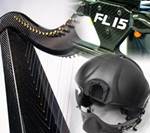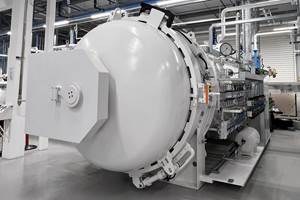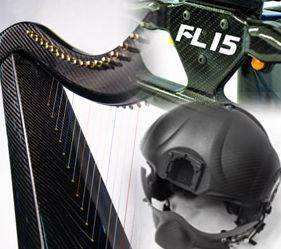Classic harps in carbon fiber
Lever and pedal models less cumbersome, still classy.
Although harp music is often described as light and ethereal, the instrument itself can be quite heavy. Traditionally a wooden structure, a harp must hold 40 or more strings in tension between a top crossbar or neck, where tuning pegs enable the player to set each string’s pitch. These are attached to the sounding board, which typically angles upward from the harp’s base. The longest (front) side or column, supports the crossbar and, in pedal harps, encloses rods that adjust string tones, actuated by pedals at the base. Lever harps, however, feature levers on the crossbar instead of base pedals to modify string tone. In wood, lever harps weigh less — 11-20 kg vs, pedal harps, which can weigh up to 50 kg. But the carbon fiber composite instruments turned out by Heartland Harps (Zirconia, NC, US) weigh a mere 4-5 kg for lever harps and 17 kg for pedal harps.
An instrument maker for 30 years, Heartland Harps’ owner David Woodworth was inspired by the weight saved by carbon fiber-reinforced plastic (CFRP) vs. aluminum poles while sailing and started thinking about the possibilities for harps. “I was the only one in the world making a curved soundboard,” he recalls of his wood harps, “so I was already out of the norm.” He began working with a custom composites fabricator in Ohio, and when he went to his first show with a CFRP lever harp, he walked away with 12 orders. “The harp-playing world is extremely conservative,” says Woodworth, “so that was a real success.”
However, orders backlogged, and Woodworth needed serious help. “That’s when I began working with Crawford Composites LLC,” he says. The Denver, NC, US, composites shop has decades of experience and excels not only at production, but also design, tooling and prototyping of highly technical, aesthetic CFRP parts for motorsports (see “Turning ideas into innovative composites” under "Editor's Picks" at top right). “They vastly improved the finish and manufacturability of our carbon harp parts,” says Woodworth, “and have been a terrific partner in the development of new models.”
“We had a significant amount of engineering work to do,” recalls Crawford Composites senior project manager Catherine Crawford. “Dave wanted to keep the shape and look of the harps, so we created a 3D solid model, using Solidworks (Dassault Systèmes., Waltham, MA, US), which we used to produce the tooling.” Woodworth says Crawford wanted to use an epoxy resin system because they were confident in its properties and resulting product quality. “We would build prototypes and then have Dave string them and try them out,” says Crawford. Woodworth would then suggest changes. Crawford gives an example: “We had to try different thicknesses and materials in order to build up the critical areas for acoustics.” Once finalized, each model would then go into production, with parts made from hand-layed prepreg supplied by Cytec (Tempe, AZ, US) and cured in one of Crawford Composites’ two autoclaves. “We cure multiple parts per cycle,” says Crawford.
Woodworth claims that his Starlight, the most recent model introduction, is the world’s first all-carbon fiber pedal harp. Crawford admits it has been the most difficult to develop. “Because the pedals have to move side-to-side and up-and-down in a certain way, there are just more parts and mechanics involved,” she explains. All of the design work was done digitally, with the finalized files sent to a 5-axis machining center supplied by C.R. Onsrud Inc.(Troutman, NC, US). Patterns thus machined from high-density foam were then used to produce molds, including a 30% scale model of the Starlight, to test performance and manufacturability before proceeding with full production.
“We’ve made over 650 carbon fiber harps,” says Woodworth. “Our harps have a great sound and are so lightweight that they sell themselves.” He notes that at concerts, players arrive, lugging in traditional harps, and then see Heartland customers carrying their instruments with little effort. Woodworth’s customers also have remarked that they can transport their new harp without worrying that it might be left in a hot car or exposed to full sun because the composites don’t react to these conditions the way wood does.
Although Woodworth offers woodgrain and painted finishes for all of the Heartland and Starlight models, he say 90% of customers choose the clearcoat carbon fiber finish. When asked if he will try new models with colored fibers or exotic weaves, Woodworth demurs: “Harps need to look classy, it’s important they don’t look or feel like plastic.”
Related Content
Industrial curing autoclaves with advanced control systems
CAMX 2025: Turnkey Akarmak autoclaves support various composite curing needs with enhanced process control, international specification compliance and optimal heat distribution.
Read MoreBusch expands autoclave solutions
Busch announces its ability to address all autoclave, oven and associated composites manufacturing requirements following the acquisition of Vacuum Furnace Engineering.
Read MorePlant tour: Airbus, Illescas, Spain
Airbus’ Illescas facility, featuring highly automated composites processes for the A350 lower wing cover and one-piece Section 19 fuselage barrels, works toward production ramp-ups and next-generation aircraft.
Read MoreAdvanced autoclaves, ovens provide efficiency, precision and intelligent control
CAMX 2025: Olmar is highlighting its next-gen autoclaves and industrial ovens for composites curing to improve throughput, scale production and achieve tighter quality control.
Read MoreRead Next
Turning ideas into innovative composites
From helmets to harps to the new Formula Lites all-carbon race car, Crawford Composites pursues perfection in a wide array of carbon fiber parts.
Read MoreCutting 100 pounds, certification time for the X-59 nose cone
Swift Engineering used HyperX software to remove 100 pounds from 38-foot graphite/epoxy cored nose cone for X-59 supersonic aircraft.
Read MoreUltrasonic welding for in-space manufacturing of CFRTP
Agile Ultrasonics and NASA trial robotic-compatible carbon fiber-reinforced thermoplastic ultrasonic welding technology for space structures.
Read More












